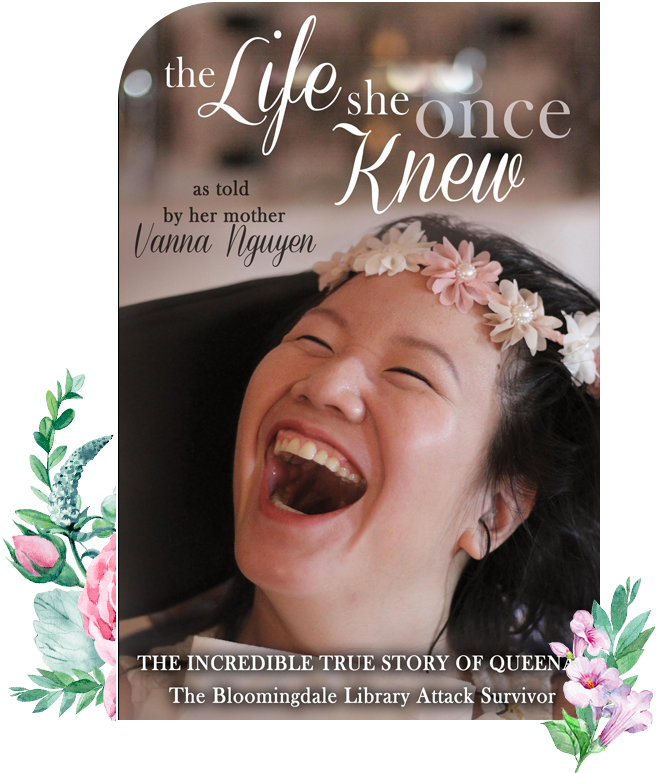Dear Vanna,
Per your request, following is a synopsis of Queena’s progress during her TheraSuit program beginning October 8, 2012 ending October 25th, 2012. A total of 36 hours of TheraSuit training was delivered by the 2 physical therapists assisted by caregivers.
Head and trunk activation: Queena gained increasing ability to bring her head to midline in the frontal and sagittal planes. She continues to demonstrate lateral neck flexion to the left with face rotated right, though to a much lesser degree. When wearing a ball cap with elastic strap with the Therasuit, Queena began to make active changes in her head position, with and without verbal/tactile prompts. Particularly positive was Queena’s new ability to keep her eyes leveled on the horizon. On the first day of treatment, Queena’s eyes remained elevated in extension with nystamus noted with beats to the right. As treatment progressed, nystagmus was rarely elicited. During the final week of TheraSuit, Queena demonstrated ability to bring her head forward and aligned in sidelying and arms forward. She was able to assist rolling with change of her head position without eliciting overflow of extensors.
When assisted to prone and positioned with chest supported on elevated wedge, Queena learned to grade extension of her head/neck and thoracic spine while manually assisted to lift. Arms functionally gained enough range to be placed forward over a roll while prone.
Queena continues to use her head rest in her wheelchair for head/neck support. She however, showed increasing abilities to move her head away from headrest observed when loading/onloading from her vehicle. She also demonstrated a “quiet controlled head resting” rather than pushing into strong extension when arriving and exiting treatment.
Sitting: Queena ended the TheraSuit session by sitting with reduced lumbar flexion, showing ability to allow her trunk to move anterior of hips when seated with knee flexion/feet loaded to surface. She responded to requests to move her trunk forward in supported sitting, keep her head at the top of her body and push to stand and return to sitting. Stance will be discussed below. Grading of control and reducing use of overall extensor posturing to accomplish stance were constantly monitored and taught through improving overall body awareness and cognitively via verbal and tactile/manual cues. Transfers to wheelchair from mat table, plinth, or seated chair were increasingly easier as the program progressed. Queena became able to control/maintain her position enough to continue to keep flexion at her hips with arms forward and elbows extended throughout the transfer.
Chanting was used in sitting with active assisted movement to improve the use of breath support to further trunk flexion for exhalation and trunk extension for inhalation. Queena grasped the pattern and participated by demonstrating improving breathing pattern and overall inhibition of tone.
Most impressive the final week of TheraSuit, was that Queena was able to flex at her hip in sidelying and maintain that control when moving towards supine or prone. She assisted with the needed hip flexion extension without loss of control. The first week and into the 2nd week of treatment right L.E. extension was very difficult to “break” for several minutes.
Standing: The change during this session was that Queena was able to have her extended arms and hands placed on a regular walker for loading rather than require a platform walker. ( At week 2 of the session, Queens required her fingers to be “pried off of a grasping surface”) Queena continued to require the assistance of 2-3 adults to assume standing with a degree of control. To us, this is a marked improvement, rather than using her total extensor posture to stand. In stance, clonus was elicited, though reduced with repetitions and with assisted weight shifts and actively contracted extensors at knees when asked to “stand” or “continue standing”. Concerns in standing are: torqueing of the body at the pelvis/hips, left knee collapses and requires frequent manual cues/assistance to remain loaded.
Overall: Queena answered questions/ made choices by indication of raising of her arms. She showed humor and response to repeated activities. “Communication/conversation” throughout the session, increased as it progressed. Queena additionally was noted to make more attempts at vocalizations, during breathing chanting activities. Queena’s affect/engagement was markedly changed for the positive by the end of the session.
It is a pleasure to work with Queena as she does give her very best effort each day. When Queena returns to us each session, we note that it takes her less time to get “up to speed”. Her endurance and will are amazing!
Positive changes are building in Queena through time with the effort of all of her teams and because of her family and community support.
We appreciate the opportunity to be part of Queena’s progression.
Sincerely,
Denise Kilburn PT
Pediatric Therapy Services
1215 E. Orange St.
Lakeland, Fl. 33801
863-802-3800
DENISE KILBURN, PT
Denise Kilburn is Queena’s Physical Therapist and is co-owner of Pediatric Therapy Services, Inc. in Lakeland, Fl.



